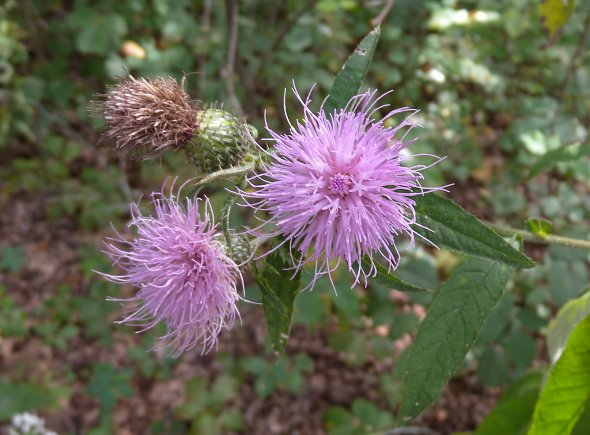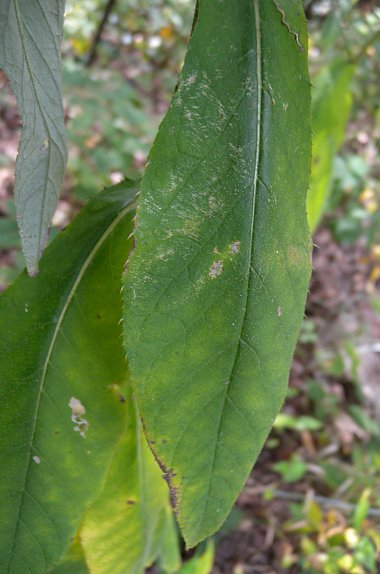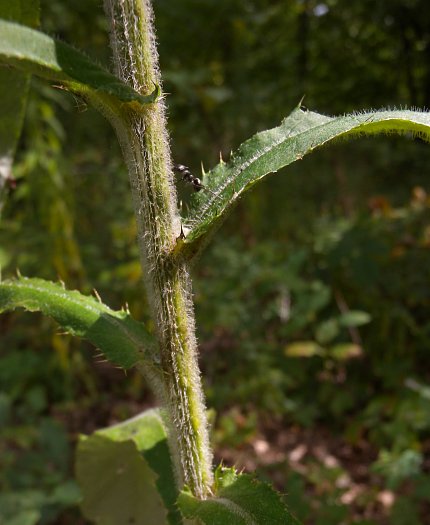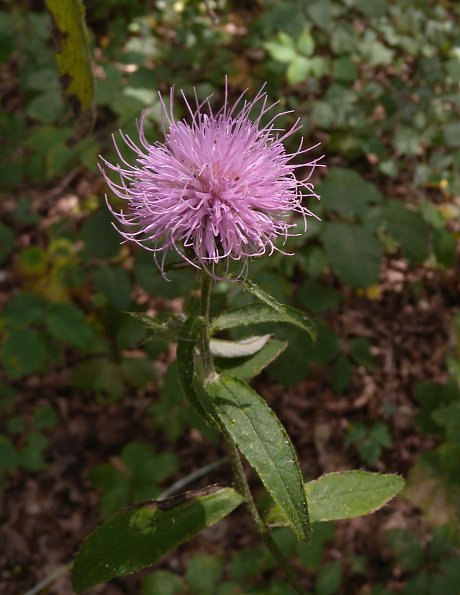Description: This wildflower is a biennial or short-lived perennial. During the 1st year, it consists of a low rosette of leaves spanning about 1' across. During the 2nd year and thereafter, it develops stems with alternate leaves and becomes about 3-8' tall. These stems are usually sparingly branched. The central stem and side stems are light green to reddish brown, terete with several longitudinal ridges, and pubescent-woolly. The alternate leaves are up to 9" long and 3" across, becoming gradually smaller as they ascend the stems. These leaves are lanceolate, oblanceolate, or elliptic in shape; their margins are entire, slightly dentate, or shallowly lobed. At the pointed tip of each lobe or dentate tooth, there is usually a spine. The upper surface of each leaf is green with appressed white hairs, while the lower surface is covered with a dense mat of white-woolly hairs. The base of each leaf is sessile or clasps its stem slightly. The basal leaves of 1st year plants are similar to the alternate leaves, except they are often more deeply pinnatifid.

The upper stems terminate in individual flowerheads spanning about 2" across. Each flowerhead has a multitude of small disk florets that are pink to purplish pink. Each floret has a tubular corolla that divides into 5 slender lobes. The base of the flowerhead is surrounded by numerous floral scales (phyllaries) that partially overlap each other. Each small floral scale is lanceolate-ovate and dark green with a white midrib; it has a dark tip, where a fine spine projects outward. Underneath each flowerhead, there are 2-3 small leafy bracts with spines along their margins like the leaves. The blooming period occurs from late summer to early fall and lasts about 1–1½ months. The flowerheads are usually fragrant. After the blooming period, the entire plant begins to wither away and turns yellow to brown. The disk florets of the flowerheads become masses of bullet-shaped achenes with tufts of cottony white hairs. These achenes are distributed by the wind. The root system consists of a taproot. This wildflower spreads by reseeding itself.

Cultivation:
The
preference is full sun to light shade, moist to mesic areas, and a
fertile loam, clay-loam, or sandy-loam soil. Tall Thistle is
more tolerant of shade than other thistles. The lower leaves may wither
away prematurely at a dry sunny site. The size of this plant can vary
significantly depending on environmental conditions.
Range & Habitat:
The native Tall Thistle is occasional throughout Illinois (see Distribution
Map). This thistle is widely distributed, but usually isn't
common
where it occurs. Habitats include open deciduous woodlands, woodland
borders, thinly wooded rocky slopes, areas along woodland paths,
savannas, thickets, swamps, meadows, areas along railroads, and
roadsides. Tall Thistle can be found in both disturbed and undisturbed
habitats; it is found in wooded habitats more often than other thistles.

Faunal
Associations:
The nectar of the flowerheads attracts bumblebees, long-horned bees
(Melissodes spp.),
Fritillary butterflies (Speyeria
spp.), Painted Lady
butterflies (Vanessa spp.),
Swallowtail butterflies (Papilio
spp.), and
Sphinx moths, including hummingbird clearwing moths (Hemaris spp.). The
pollen also
attracts Halictid bees and other bees, Syrphid flies, and various
beetles (Robertson, 1929; Graenicher, 1907). Other insects feed
destructively on the foliage, sap, and other parts of Cirsium spp.
(thistles). These insects include Oulema
palustris (a leaf beetle), Cassida rubiginosa
(Thistle Tortoise Beetle), Euphoria
inda
(Bumble Flower Beetle), Melanoplus
borealis (Northern Grasshopper), Entylia bactriana
(a treehopper), and
such aphids as Brachycaudus
cardui (Thistle Aphid), Capitophorus
elaeagni (Artichoke Aphid), and Uroleucon cirsii (Large
Thistle Aphid);
see Clark et al. (2004), Marshall (2006), Cranshaw (2004), Funkhouser
(1917), and Brust et
al. (2008). The caterpillars of two butterflies, Calephelis muticum
(Swamp Metalmark) and Vanessa
cardui (Painted Lady), also feed on
thistles (Opler & Krizek, 1984; Wagner, 2005), as do the
caterpillars of several moths (see Moth Table).
The American Goldfinch, Clay-colored Sparrow, Pine Siskin,
Slate-colored Junco, and Indigo Bunting eat the seeds of thistles; the
American Goldfinch also uses thistle-down to line its nests (Martin et
al., 1951/1961; DeVore et al., 2004). Although the Tall Thistle is less
heavily armed with spines than some thistles, they provide some
protection from hoofed mammalian herbivores.

Photographic
Location:
Along a woodland path at Fox Ridge State Park in east-central Illinois.
Comments:
As the common name suggests, this thistle can become quite tall. It
resembles Cirsium discolor (Pasture Thistle) and
other common thistles, except that its leaves are less pinnatifid and
spiny. The native Pasture Thistle prefers habitats that are more dry
and sunny, but it is also sometimes found in wooded habitats. An
aggressive Eurasian species, Cirsium vulgare (Bull
Thistle), also prefers habitats that are more dry and sunny; it is even
more heavily armed with spines than the Pasture Thistle. Unlike the
Tall Thistle and Pasture Thistle, the Bull Thistle has leaf undersides
that are more green because they are less densely hairy. The leaf
undersides of the preceding native thistles are bright white because
they have dense mats of white-woolly hairs. All of these tall-growing
thistles are in bloom at about the same time of year and their erect
flowerheads are pink to purplish pink.